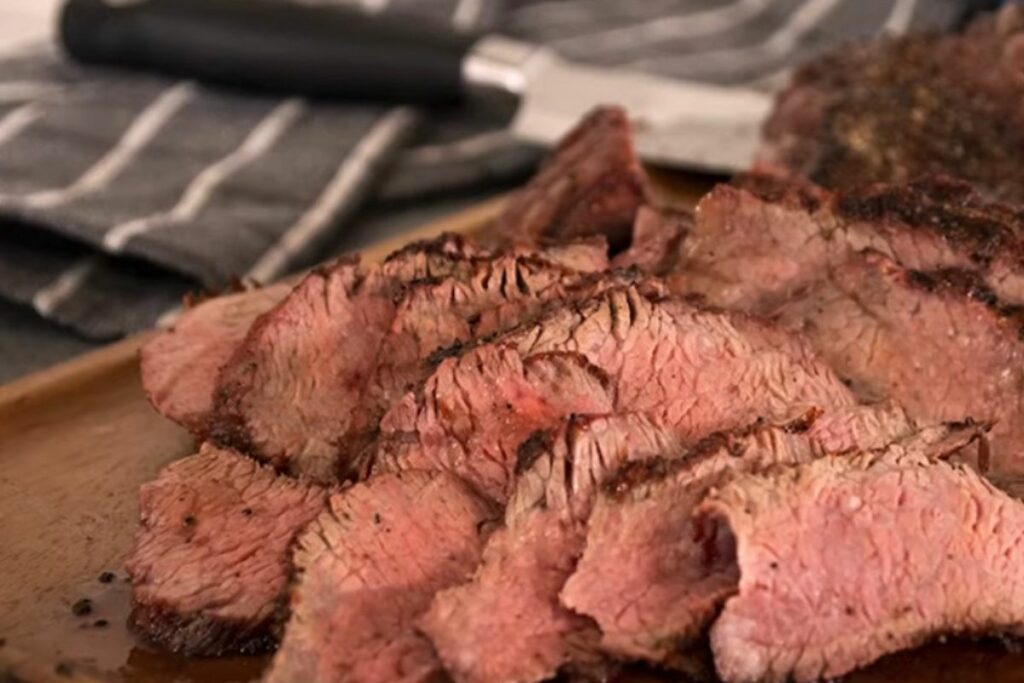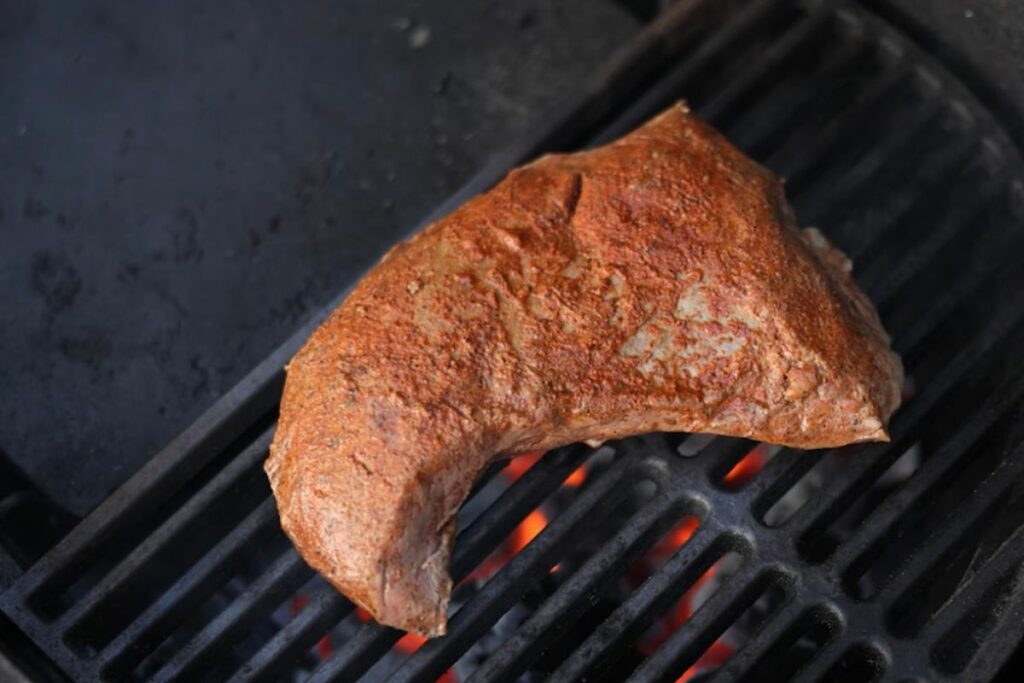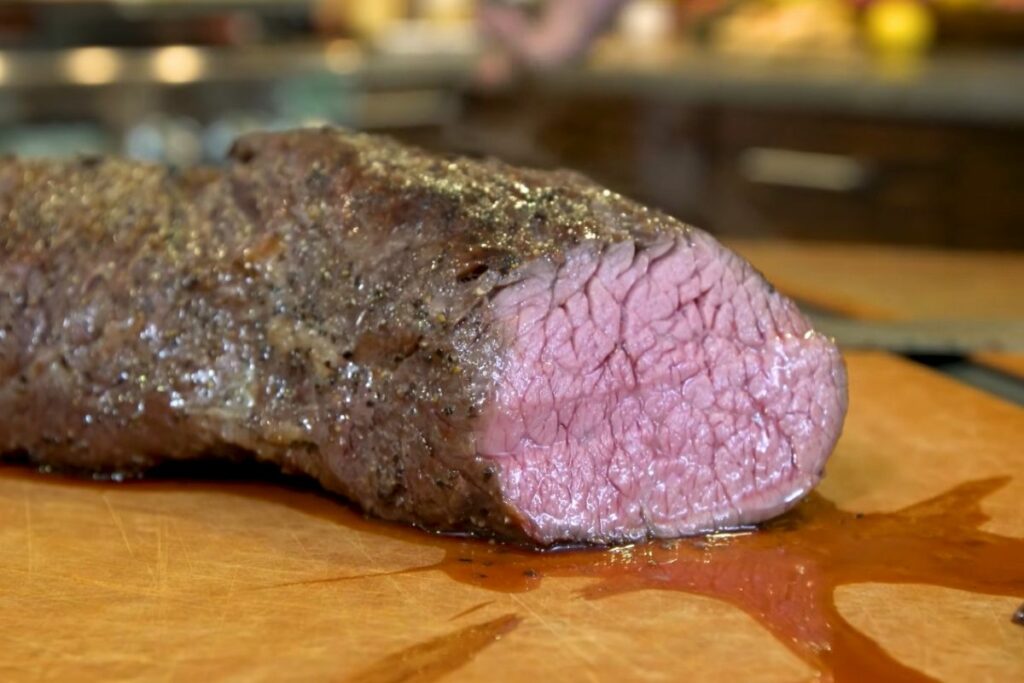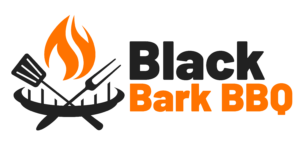If you’ve never heard of tri-tip before, it’s a cut of beef taken from the bottom sirloin. Tri-tip can be served in several ways, as it tastes great when it’s grilled, smoked, roasted, and rotisseried.
Tri-tip roasts can weigh anywhere between 1.5 to 2.5 pounds depending on how much meat is taken off the bone. As it weighs more than brisket or short ribs, butchers normally cut the tri-tip into smaller pieces.

This is why the term tri-tip is confusing, as it can relate to smaller tri-tip steak pieces or the full tri-tip roast. However, there isn’t any difference when cooking tri-tip, as smaller steaks and the whole roast can be cooked to the same internal temperature.
So, this brings one question to mind – when the tri-tip is done, what will its internal temperature be?
In short, tri-tip steaks and roasts are best enjoyed when they reach 130-140°F on the inside. For tri-tip, this temperature is known as medium-rare to medium, an ideal level for eating.
You’ll learn more about tri-tip in this article, such as the best ways to measure their internal temperature, and how to prepare tri-tip for cooking.
What Are Tri-Tip Cuts?
As mentioned earlier, tri-tip comes from the lower section of the sirloin. The cow’s bottom sirloin butt has three main components, the tri-tip, flap, and ball tip. The tri-tip will be found in the cow’s rear sirloin tip segment, next to the round area.
tri-tip will be cut away from the flap and ball tip away from its natural seam. All of these parts will be sold commercially as individual cuts.
The North American Meat Processors Association numbers the tri-tip as 185C, while the flap and ball tip are known as 185A and 185B, respectively.
In most cases, the trip tip will weigh between 1.5 to 3 pounds. It’s unlike brisket, a cut that’s found on the cow’s lower breast.
Brisket will have a lot of collagen and tissue between the muscles. These can only break down after being cooked for a long time over low heat.
tri-tip is more similar to flank in that it has little connective tissue within. Flank is found closer to the cow’s stomach, towards the rear.
Flank does have longer muscle fibers, but as it doesn’t have as much connective tissue, it cooks relatively quickly, as other steaks do.
Just don’t forget to cut across the muscle grain. This cuts through the tough connective tissue, making the steak tender and easier to chew.
Like the flank, the tri-tip doesn’t have much interconnective tissue between the muscles. This makes it easy to cut against the grain.
You just need to make sure you’re cutting with enough pressure to avoid tearing the meat apart. Always use sharp knives to ensure you get a clean cut.
Alternative Names For Tri-Tip
Different locations call tri-tip by other names, including Newport Steak, Triangle Roast, and the Bottom Sirloin Tip. tri-tip is well-liked within the western United States, especially in California.
This explains another two tri-tips names, the California Cut and the Santa Maria Cut.
Some claim that tri-tip began in California, more so in Santa Maria, a city on California’s central coast. In these areas, tri-tip is often linked with barbecue.
Some say that tri-tip originated in the 1950s at the Santa Maria Meat Company, though believe that tri-tip was first introduced in the 1930s. Regardless, tri-tip has been popular in California for a long time.
Tri-Tip In Santa Maria
If you often frequent California or are a grilling enthusiast, you may already know about the Santa Maria tri-tip.
Though the story of its origins is a little hazy, most people believe that tri-tip began in a Safeway grocery store in 1952, located in Santa Maria.
In 1952, the sirloin’s triangular tip was simply trimmed for use in stews or ground beef. The story says that the grocery store’s meat department had an excess of stew meat and hamburgers on its hands.
They then decided to rotisserie cook the leftover top block sirloins, now known as the tri-tip roast.
This experiment turned out to be one of the best decisions ever made. Rotisserie cooking is one of the best ways to cut the tri-tip. Cutting it across the grain made the roast tender and easy to chew.
The Santa Maria tri-tip became a local favorite and eventually spread throughout Central California. Today, many restaurants and food trucks continue to serve this delicious cut of meat.
A classic way of cooking tri-tip is in traditional Santa Maria fashion. Simply prepare the meat with a dry rub and cook it on a grill.
The best grills will be open-air models with strong gauge gates. You can change how close or far the meat is from the heat by lifting the gates with a pulley.
tri-tip cooked in Santa Maria style is often served alongside pinquito beans, crusty bread, and Santa Maria Style salsa.
How To Trim And Prepare Tri-Tip
You need to trim off some of the outer fat from the tri-tip before you can think about cooking it. If you’d prefer to leave the fat on, feel free to do so, but beware. The fat can make it harder to evenly cook the tri-tip.
tri-tip roasts that haven’t been trimmed will have a lot of thick fat around them. Tri-tip tends to cook quickly, so the fat won’t have enough time to break down and moisten the meat.
The fat on the tri-tip will have a thick membrane that can prevent heat from reaching the meat. This is inefficient as it stops the meat from cooking well all the way around.
Trimming the fat is one way of ensuring the tri-tip will cook evenly all the way through.
Remember that the untrimmed tri-tip muscle side will have skin and fat pockets. You will need to remove these before cooking the meat.
A lot of tri-tip roasts bought from the grocery store tend to have a lot of fat left on the cut. Good butchers will be able to trim the fat off for you, but you can do it yourself if you’re handy with a knife.
If you’re buying tri-tip roasts pre-packaged on a tray, there are likely to be thick layers of fat around the meat. It’s not hard to get rid of them, but make sure you do so before cooking.
The goal is to trim away any excess fat without removing too much of the meat.
Measuring The Tri-Tip Internal Temperature
When you’ve finished cooking your tri-tip, you’ll want to check its internal temperature. You can track this with an oven if you prefer, but the best way is by using a probe meat thermometer.
No matter what kind of meat you’re dealing with, the internal temperature is the most important factor you’ll need to be aware of as you cook.
Recipes may give estimated cooking times, but these are only best guesses. Various ovens, grills, and smokers will all make a difference. You may need to cook your meat for longer or less, depending on your model.
The best thermometer that can track your tri-tip internal temperature is one that’s oven and grill safe. These will have a probe that goes into the center of the meat, which is usually the thickest part.
You’ll be able to read the temperature from the outside.
You can opt for instant-read meat thermometers, but be careful, as you’ll need to be wary of the time.
When cooked at 400°F and the meat has passed searing, a tri-tip that weighs 1.5lbs will just need 15 minutes to reach 130°F.
How To Cook Tri-Tip Well

You don’t need the extremely modern grills to cook tri-tip, all you need is a decent gas or charcoal grill. Tri-tip cooks well when using a two-zone fire setup.
These allow you to, directly and indirectly, cook the meat, letting the tri-tip be crisp on the outside, but juicy in the middle.
Your grill grate should be around 500-600°F when placed under high direct heat. The other side of the grill will either be turned off, or it won’t have any coals placed on it.
This side of the grate will roughly be 200-250°F, a temperature that avoids overcooking the outside of the meat.
tri-tip will cook through quickly, even at a lower temperature, as it doesn’t have that much connective tissue within it.
Two-zone fires aren’t just good for grilling larger pieces of meat, they’re good to use whenever you grill.
If you’re cooking several foods on the direct-heat side, they can all be moved towards the indirect heat side once they’re ready.
The dual-heat system and consistently monitoring the temperature are simple, but effective ways of ensuring several food items are done at the same time.
Managing the temperature is one of the most important things you should learn when grilling. A common issue is when inexperienced grillers turn on all of the burners or spread coals across the whole grill.
This makes it difficult to manage the temperature, whereas two-zone setups let you control the temperature on both sides of the grill.
When food is placed on the side that isn’t generating heat, it will slowly cook from indirect heat flowing from the hotter side.
Resting The Tri-Tip
You should always rest your meat after grilling it, but this becomes an even more important step when you’re dealing with a larger steak, like tri-tip.
Larger meat cuts will have bigger protein fibers than don’t retain juices as easily as smaller fibers.
Resting the meat allows the bigger protein fibers to slacken after cooking. They will then retain more moisture than if they were served immediately after grilling.
Keep in mind that resting may make the tri-tip’s juices flow out more easily compared to other types of meat. You can find carving boards with grooves that catch the juices which may reduce the mess.
Cutting Tri-Tip After It’s Done
Once you’ve checked the internal temperature of your tri-tip, you should be ready to carve it up. tri-tip has a visible muscle fiber pattern that runs across in different directions.
If you examine a tri-tip roast carefully, you should see its muscle fibers in vertical and horizontal lines.
If you’re cutting tri-tip meat for serving, you’ll need to cut against the grain. Place a long, sharp, slicing knife at a 45-degree angle, as this will allow you to slice the muscle fibers more easily.
This cutting method will make the meat more tender and easier to eat.
Use the knife to cut the meat against the grain, working in two different directions. If you prefer, you can cut the tri-tip into two sections where the two muscle fiber patterns cross. This may make the meat easier to carve.
Now you know how to carve tri-tip, we can look at the different ways of cooking it.
Delicious Tri-Tip Recipes
One full tri-tip roast can weigh a lot, from between 1.5 to 2.5 lbs. As it’s so large, you need to watch out. It can be easy to overcook the outer area before the inside reaches optimum temperature.
You can avoid drying the meat out by searing the outside, then finishing it off over indirect heat. To do this, sear the tri-tip over high heat.
Sear each side for no more than 3 minutes. Next, cook the meat over indirect heat for 15-20 minutes.
Remember that this time recommendation is just an estimate. The size of your meat will affect how long you cook it. Searing also has an advantage, as it gives the meat pleasing grill marks on the outside without overcooking the inside.
The recipe below is a classic Santa Maria recipe. If you choose to use the searing and indirect heat method above, it should take you around 21 minutes to grill the tri-tip.
How To Make Santa Maria Grilled Tri-Tip
Ingredients
- One tri-tip roast, weighing 1.5 to 2.5 lbs
- A tablespoon of garlic powder
- A tablespoon of Kosher salt
- A tablespoon of black pepper
You can substitute this rub for any BBQ rub if you prefer a different flavor.
Recipe
Follow our steps below to make the delicious tri-tip!
- Santa Maria tri-tip is normally cooked over red oak wood. If you have wood chips on hand, you can place a few into the charcoal, or if you’re using a burner, into the foil packet.
- Begin by preheating the gas grill; setting all the burners on medium-high for ten minutes.
- For charcoal grills, prepare your chimney with briquettes. Keep monitoring the tops. Once they turn gray, place them onto one half of the grill so the other half has no coals in it. This will give you a two-zone fire.
- After the grill is heated sufficiently, ensure that the grill grates are well oiled and free from grime, grease, or dirt.
- Now we can start cooking the tri-tip. Place the meat straight onto the hot side of the grill, then sear for 3 minutes. You can sear for longer if you prefer, but don’t exceed 5 minutes.
- After you’ve seared one side, flip the meat over and sear the other side for another 3-5 minutes. Make sure that it doesn’t cook too much on either side.
- Once the tri-tip has seared on both sides, you can place it on the grill’s cooler half.
- If you’re using a gas grill, turn one side of the burners off, then place the tri-tip on that side.
- If you’re using a charcoal grill, simply place the tri-tip on the area free from coals.
- This is the best time to use your probe meat thermometer. Simply stick it into the thickest part of the meat, being careful so you don’t burn yourself.
- Place the lid back on the grill, then cook for 12-15 minutes.
- If your tri-tip is lighter, less than 1.5lbs, you can begin checking the internal temperature when 12 minutes have passed. Larger cuts over 2.5lbs will take longer to cook, so you may want to check at 14 minutes.
- You can take the tri-tip off of the grill once the thermometer reads 125-130°F unless you prefer your meat well done. Once the meat is off of the grill, leave it for ten minutes so it cools down. You can then slice the meat against the grain in the manner described above.
Santa Maria-style tri-tip is best served with Santa Maria salsa, pinquito beans, and thick, crusty bread. We’ve added some recipes for the salsa and beans below.
How To Make Santa Maria Pinquito Beans
Pinquito beans are small pink beans found along the California central coast. This recipe goes great alongside the Santa Maria tri-tip.
Pinquito beans can be hard to find, but if this is the case, you can swap them for pink or pinto beans.
Ingredients
- Two 15 ounce pinquito bean cans
- Four bacon strips
- One 10 ounce can of diced tomatoes
- Two tablespoons of chili sauce
- A teaspoon of brown sugar
- A teaspoon of paprika
- Half a cup of diced smoked ham
Method
- Begin by cooking the bacon in a skillet until it’s crispy.
- Once it’s done, remove the bacon, then cook some garlic in the bacon fat for a minute.
- Add the remaining ingredients apart from the bacon, then cook for five minutes.
- Add the bacon strips to the mix at the end, then serve in a bowl.
How To Make Santa Maria Salsa
Santa Maria salsa tastes amazing with crusty bread, especially when paired with Santa Maria tri-tip and pinquito beans, as described above.
Ingredients
To make the salsa, you will need:
- A pound of finely chopped red tomatoes
- Two celery sticks chopped finely
- Three green onions, chopped finely
- Two Anaheim chiles, chopped
- Half a bunch of cilantro
- One lime, juiced
- A dash of white vinegar
- A dash of Tabasco sauce
- A dash of Worcestershire sauce
- Salt, pepper, garlic for seasoning
Method
- To make the salsa, simply combine all of the ingredients in a bowl, then add salt, pepper, and garlic to taste. That’s it!
Tri-Tip Oven Roast Recipes

The best way to cook tri-tip roasts and smaller steaks inside is by searing them over a skillet, then finishing them off in the oven. The sear will caramelize the meat on the outside, making it pleasantly crusty, while the inside meat remains tender and juicy.
You can cook tri-tip steaks in the oven in two ways. The first is by cooking the whole tri-tip roast in the oven. The second is by using the butterfly technique, which is a great way to cut larger meat cuts in less time.
If you prefer, you can also cut the tri-tips into separate smaller steaks.
The butterfly method involves cutting the tri-tip lengthways, essentially slicing into its side.
Place the tri-tip onto a cutting board, then slice the steak in half horizontally. Don’t cut the steak all the way through, you should stop before the knife reaches the other side.
Now you can open the steak up like a book, which explains the ‘butterfly’ method’s name. Cooking the tri-tip whole can be done, but it will take more time.
How To Cook Tri-Tip In The Oven: Butterfly Method
tri-tip cooks well in an oven set to 400°F, no matter if the meat remains whole or has been butterflied.
Ingredients
- A butterflied tri-tip roast weighing 1.5-2.5 lbs, or tri-tip steaks
- Salt and pepper for seasoning
- Olive oil
Method
- Begin by preheating the oven to 400°F.
- Next, heat a large skillet with a tablespoon of olive oil over medium-high heat.
- Saute the tri-tip for 4 minutes on either side, then place in the oven. Place your oven-proof probe thermometer in the thickest part of the meat.
- Once the tri-tip thermometer reaches 120-125°F, remove it from the oven and leave it to rest for 5 minutes. The leftover heat will slowly take the tri-tip to a medium-rare stage.
- If you prefer meat that’s more done, leave it in the oven for a few more minutes, taking care not to overcook it.
- After the meat has rested, take a long, sharp slicing knife to cut against the grain. You can then serve alongside your chosen side dishes.
How To Cook Whole Tri-Tip Roasts In The Oven
Ingredients
- A whole tri-tip cut of meat
- A tablespoon of olive oil
- A teaspoon of black pepper
- Two teaspoons of kosher salt
- Half a teaspoon of garlic powder
Method
- Begin by preheating the oven to 400°F.
- As the oven heats up, heat a heavy, large skillet with the olive oil over mid-high heat. Wait until the oil starts to flicker, then rub the meat with the dry rub ingredients: salt, garlic powder, and pepper.
- Next, place the tri-tip in the skillet to brown the meat on all of its sides.
- Once the tri-tip has browned nicely, transfer the skillet, with the tri-tip still in it, to the oven.
- Let the meat cook, then check around ten minutes after to see if it’s done using an instant-read meat thermometer.
- If you want the tri-tip to be medium-rare, take it out of the oven once it reaches 120-125°F.
- If you prefer your meat more done, leave it in the oven for longer, taking care not to overcook it.
- Let the tri-tip rest for ten minutes. The leftover heat will slowly cook the meat so its internal temperature reaches 130°F. Resting the meat will let the juices redistribute throughout the tri-tip.
- To finish, slice the meat against the grain, then serve alongside your favorite side dish.
How To Avoid Chewy Tri-Tip
Chewy tri-tip is never a good thing, but it can happen when the meat is cooked too quickly. Here are some ways that you can avoid cooking chewy tri-tip.
- Try massaging oil into the meat before cooking. The massaging potion and the oil will tenderize the meat, so it won’t be as hard or chewy in the mouth.
- Marinate the meat for as long as possible. This will ensure that the meat becomes tender and is infused with a lot of flavors. Eight hours is ideal, but even if you only have an hour on your hands, the meat will roast better than it would have without marinating.
- Take the meat out of the refrigerator around half an hour before cooking, so it will begin cooking at room temperature. Colder meat will take longer to cook, increasing the chances of the tri-tip overcooking later.
- Always use a meat thermometer! Keep in mind that the meat will continue to cook after it’s been taken off of the grill, due to the residual heat. A good rule of thumb is to take the meat off of the grill (or oven) when it reaches 5 degrees below your desired doneness level.
- Make sure you slice the meat correctly. Slicing meat incorrectly can make the cut difficult to chew. In the case of tri-tip, always slice against the grain, using a long, sharp slicing knife.
Conclusion
Tri-tip is becoming more and more popular outside of California, thanks to its tender nature and versatility. tri-tip cooks very quickly as it hasn’t got a lot of connective tissue within, so it’s important to know how to avoid overcooking.
You can do this by monitoring its internal temperature with a probe thermometer. Medium rare tri-tip reaches around 120-130°F on the insides.
It can be hard to guess when you should take the meat off from the heat without a thermometer, so it’s always best to invest in one.
Make sure that you cut the tri-tip against the grain, as cutting it any other way can result in tough, chewy meat. It’s always a good idea to remove the fat before cooking it as well, as the fat can prevent the meat from cooking evenly.
There are many ways to prepare tri-tip, so whether you prefer the Santa Maria style, classic BBQ rubs, or simple salt and pepper seasoning, you’re sure to fall in love with this versatile cut of beef!
Frequently Asked Questions
What Should The Internal Temperature Of The Tri-Tip Be?
Both tri-tip roasts and smaller steaks become tender and juicy when their insides measure around 130 degrees Fahrenheit. tri-tip is considered medium to medium-rare at this temperature.
You can measure the tri-tip internal temperature by using an instant-read meat thermometer. These will have a probe you can stick into the thickest part of the meat to check whether it’s done or not.
Is Tri-Tip Roast The Same As Tri-Tip Steak?
Tri-tip is a cut of beef taken from the bottom sirloin. A tri-tip roast normally refers to the tri-tip cut as a whole, before it has been sliced into pieces.
Tri-tip steaks are separate slices of tri-tip roast. A tri-tip roast can weigh a lot, up to 2.5 lbs, so butchers often cut the meat into smaller pieces for convenience.
Should You Cook Tri-Tip The Fat Side Up Or Down?
If your tri-tip cut hasn’t been trimmed on one or both sides, it’s always better to trim as much fat away as you can. tri-tip cooks very quickly, but fat doesn’t. The fat layer can make the tri-tip meat cook slowly or unevenly through.
If you’re grilling the meat, use a sharp knife to trim as much of the fat away as you can. If you’re baking it in the oven, make sure at least one side is free from the fatty layer.
In this case, place the meat in the oven fat side up so the fat cooks first. This will let the fat’s juices keep the meat tender and moist upon serving.
Should You Wrap The Tri-Tip In Foil?
Whether you’re grilling or baking tri-tip in the oven, don’t wrap it in foil. The foil will prevent the meat from crisping up nicely on the edges.
If you do prefer to cook your meat in foil, take the foil off of the tri-tip for the last few minutes.
The only exception is if you’re cooking the tri-tip in the oven and notice that the meat is looking black towards the end. If this occurs, you can fold foil into a tent and put it on top of the meat.
The foil will help to protect the meat from burning further and will trap moisture in the meat, so it doesn’t taste as dry.
- Is Blue Steak Safe To Eat? - May 7, 2022
- How To Tell If Your Bratwurst Sausage Is Cooked - May 7, 2022
- The Internal Temperature For Tri Tip When Done - May 7, 2022








